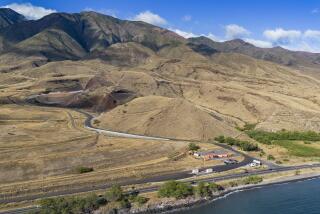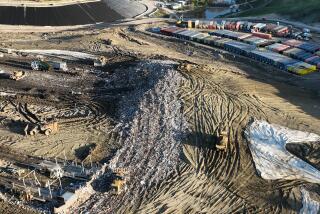For Lopez Canyon Landfill Neighbors, a Long Goodbye
KAGEL CANYON — Don Showalter is talking about the noisy trucks that used to ferry trash to the nearby Lopez Canyon Landfill when he suddenly leaps from his chair and points out the window.
On the hillside outside his modest wood shake home, a black-and-tan bobcat stops and looks in his direction before bolting into the brush.
“Look, can you see it?” he says, trying to get his wife, Shannon, to pull herself away from “Oprah.” “It’s right there on the hill. It’s right there.”
Wildlife is common here, and along with the solitude, it’s one of the reasons people like the Showalters say they fought to close the Lopez Canyon Landfill.
The dump operated about a mile from here for more than 20 years, but since its closure in 1996, few outward signs remain of the 400-acre landfill--the last major dump to be owned and operated by the city of Los Angeles. Yet even in relative peace, the dump’s hulking presence is inescapable.
Past the rolling hills at the crest of the winding canyon road, a denuded mountain of brown, terraced dirt rises in the distance, offset by scattered stands of oak trees and the rolling lawns of Glen Haven Memorial Park.
From the roadside, it’s hard to get a sense of activity. But it’s there, within the confines of the landfill, where about 70 people--from engineers and equipment operators to laborers and gardeners--are still working on closure of the facility.
Orange-vested city crews monitor methane gas levels, seed the dirt-covered hillsides and install drainage and gas pipes that crisscross the landfill, from the amphitheater-shaped front to the backside slopes overlooking Kagel Canyon.
Bureau of Sanitation Supt. Kurt E. Reschke estimates the city spends $2 million to $3 million annually at the site. Once the mitigation efforts are completed, sometime in 2002 or 2003, the budget will drop by about half.
Beyond that, sanitation officials say, some expenses will remain to monitor gas emissions, and to ensure structural integrity and general upkeep.
Future of Site Is Uncertain
There has been some talk about eventually building a golf course on the site, but workers at the landfill discount that possibility because of fill sinkage and a lack of interest.
A more likely outcome is that the city will go ahead with plans to plant native vegetation on the hillsides to better blend with the natural scenery.
“When we were open, we worked to make it the best it could possibly be,” Reschke said. “I’ve been in the landfill business 20 years and I know when this place closed each evening, it looked like an area set for a housing development. It still does.”
Lake View Terrace resident Phyllis Hines agrees that the landfill does look clean. But while trash is no longer being buried in the canyon, she says, residents are still burdened with the dump’s legacy.
She notes that contaminants mixed with methane, secreted from decomposing trash, must be burned off continually, adding to air pollution over local homes. Residents also say rats, drawn initially by the dump, are now firmly entrenched in the area.
“Just because a dump is closed doesn’t mean it doesn’t go on living,” said Hines, one of the leaders in the effort against Lopez Canyon. “The effects of this landfill will live on for at least 30 years.”
To compensate residents for the inconvenience of the dump, the city created a $5-million community “amenities fund.” Today, the city controller’s office says about $850,000 remains unspent.
Hines said funds originally were slated for an at-risk youth program, renovations and additions to the Lake View Terrace Recreation Center, a new branch library and other local causes.
But the funds were diverted to projects outside communities in the immediate area of the dump, including Lake View Terrace and Kagel Canyon.
Among the projects that should have waited for other funding were a new $300,000 Sylmar library; a $250,000 computer learning center for the Pacoima Boys & Girl Club; $100,000 for the Pacoima Senior Center and $100,000 for a Neighborhood Watch Trust Fund, she said.
Hines blames state Sen. Richard Alarcon (D-Sylmar) for diverting funds to projects in Sylmar and Pacoima--away from the neighborhoods nearest the dump--when he served on the Los Angeles City Council and represented the northeast Valley.
Alarcon says he is satisfied with how the money was spent. He says the projects were not only worthwhile, but they were picked by a community advisory board made up of local residents.
“I could have spent it anywhere in the 7th Council District, but the advisory group defined where the money should be spent,” Alarcon said. “And I never allocated any money outside the impact areas.”
Controversy Now Over Sunshine Canyon
For the most part, however, the Lopez dump issue has gone away. The biggest controversy now swirls around the Sunshine Canyon dump in Granada Hills.
On Oct. 26, the City Council approved expansion of the Sunshine Canyon landfill.
At least one veteran of the Lopez Canyon fight who is following events in Granada Hills says she feels guilty for not doing more.
“You get burnt out,” said Marge Miller of Kagel Canyon. “I was in this from 1979 to 1996.”
Even if they wanted to, they may not have helped because Sunshine is owned by Browning Ferris Industries and is regulated by both the city and county of Los Angeles.
“We not only have to deal with a corporation that stands to make millions, if not billions of dollars from this project,” said Sunshine Canyon opponent Mary Edwards. “We also have had to deal with the county and the city.”
Edwards notes that Sunshine is much bigger.
Lopez Canyon holds about 19.2 million tons of trash, about 2.6 million tons short of its original capacity, according to the Sanitation Bureau.
By comparison, about 55 million tons of refuse is expected to make its way into the Sunshine Canyon landfill over the next 26 years, though opponents put the real number closer to 90 million tons if the Los Angeles County portion of the facility is factored in.
“To put it in perspective, Lopez Canyon accepted a third of the 24,200,000 pounds of trash that Sunshine Canyon will accept every single day,” Edwards said. “That’s a lot more dirty diapers, contaminated soil, hospital waste and packaging materials.”
Drew Sones, an assistant director of sanitation for the city, says the trash has to go somewhere, and traditionally canyons at the edges of the San Fernando Valley have been close and well-suited for that use.
Even with recycling, their trucks cart away 3,400 tons of trash from 720,000 residential stops each week, he says. Private haulers take additional tons from business and industry.
Even if Sunshine Canyon foes are able to block the expansion of the dump, veterans of the Lopez Canyon wars will tell them that the problem won’t go away.
Don and Shannon Showalter said all they can do is wait. Wait for nature, which first lured them here, to eventually take its course.
More to Read
Sign up for Essential California
The most important California stories and recommendations in your inbox every morning.
You may occasionally receive promotional content from the Los Angeles Times.









